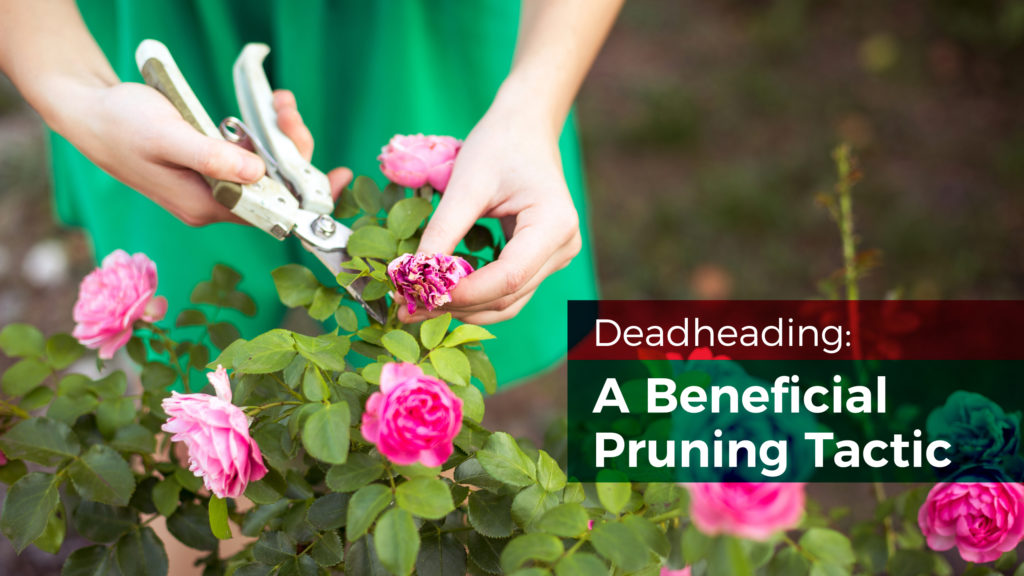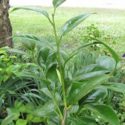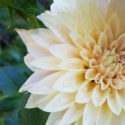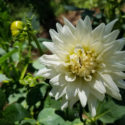Although it might seem contradictory, removing blooms can actually promote growth in your garden. While pruning is a selective and targeted technique — its goal to remove unproductive, unhealthy, or otherwise undesired plant tissue — the more specific practice of deadheading eliminates “spent” blossoms from plants so new ones can take their place. Of course, you should never forget your gardening basics like proper lighting, rich soil, and wholesome nutrients — but as a supplemental care routine, pruning and deadheading can prove quite fruitful. Whether you spend your effort producing homegrown vegetables or scenic landscaping, these trimming tactics from Jobe’s can help your garden thrive.
Why Prune?
Pruning is kind of like a fresh haircut: You look better afterward, but it’s also for the sake of your hair’s health and liveliness. In pruning terms, to trim off your split ends so new hair can grow is to remove old buds so new flowers can bloom. And both processes are selective. You’re looking to shape your hair how you want it, for both cosmetic and practical reasons. You might want to get bangs, or layers to thin out your locks, or a buzz cut for the summer — whatever the hairstyle, you want to look good and feel comfortable. However, you wouldn’t schedule a hair appointment without really needing one or knowing what you want. When pruning, understanding your plants’ needs is crucial.
Plant Good Habits
Generally speaking, you’re trying to control and create specific patterns for your plants’ development, and not unlike humans, most plants should be trained with good habits when young.
While some may claim that making formative pruning cuts to a young plant will wound it, in fact the opposite is true: Juvenile stems and branches will heal and get into shape quickly, so they require less maintenance in the future.
Maintain Health
When pursuing a healthy lifestyle, we agree to throw away certain bad behaviors. When pruning, we eliminate any deceased or diseased parts that reduce the livelihood of our plants. You may also want to thin out overgrowth to allow more light and airflow, which reduces the likelihood of pests or disease. The focus is, ultimately, on the yield; if pruned correctly, your fruits, vegetables, or flowers will flourish even more.
Restrict Hazards
Make sure there aren’t too many cooks in the kitchen (or, for our sake, plants in the garden). If a tree, for instance, becomes too weighed down by dead limbs, falling branches are a potential risk to you or your surroundings. This may also involve redirecting growth, either to avoid overcrowding surrounding vegetation or to improve balance and structural soundness.
Deadheading: A Specific Pruning Tactic
Fear not — deadheading isn’t as sinister as it sounds, but rather quite the contrary. It helps ensure frequent and beautiful flowering or continued harvest production. You should consider this technique mostly for blooms that don’t produce decorative seed heads — the dried flowering parts of plants that contain the seeds. Thus, flowers, like lilac or peonies, as well as herbs and vegetable plants, would be contenders.
On the other hand, plants that will not produce more flowers might develop seed heads that offer protection or yield seedlings the next year. Old hydrangea flowerheads, for example, help protect next year’s buds from frost, and sunflower seeds serve as bird food during the winter. Therefore, avoid snipping these and other types of plants, like poppies, sedum, and ornamental grasses. Otherwise, there are plenty of practical reasons to deadhead.
Encourage New Blooms
Essentially, plants flower so they can set seed. The deadheading process not only increases the amount of seeds set but also extends the length of the blooming or harvest season; continuous removal of flowerheads simply spurs more growth. Many annuals — like marigolds, petunias, and zinnias — and perennials — like Rudbeckia and Echinacea — will continue to bloom if deadheaded. Even edible crops benefit because the energy can focus on nurturing a fruitful product.
Conserve Energy
Think about deadheading this way: If you’re removing blooms and restricting the plant from setting seed, it has to use that energy elsewhere, typically resulting in more growth. Regular removal of dead blooms redirects the energy from seed development into flower or fruiting development, promoting a healthy and vigorous garden. Even perennials that bloom only once per season benefit from having their stalks cut back, as the energy is channeled back to their roots and vegetation.
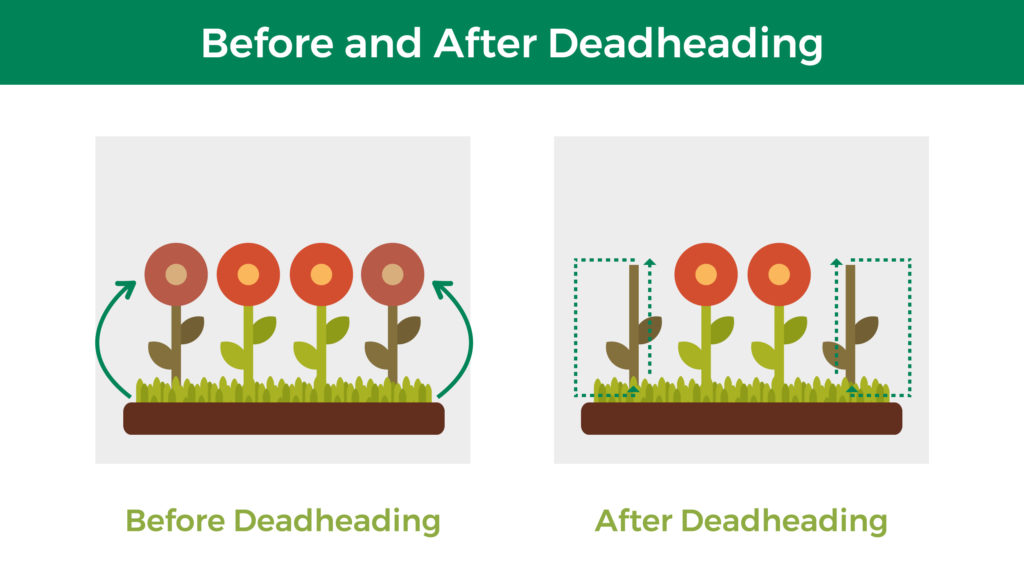
Before deadheading, dead blooms are still on the plant. After deadheading, the dead blooms are removed, and the plant directs that energy from seed development to flower or fruiting development.
Prevent Excess Seed Formation
If left to their own devices, self-sowing plants like bellflowers and chives can outgrow their spaces rapidly. Deadheading prevents seed formation in the first place, so if you’re looking to control the volume of a certain species, keep up with flowerhead removal. Keep in mind that plant reproduction, of course, varies upon growing conditions and plant type.
When to Make the Cut
Perennials that don’t fare well in the cold are best pruned in the fall so issues like pests and diseases won’t resurface from their dead foliage come spring. Others could benefit from the winter protection of their fallen leaves, in which case springtime pruning is your best bet. The timing also depends upon where you live and the plant’s blooming season, so there are no hard-and-fast rules. Especially for garden vegetables, pruning methods are debated, with some arguing that it’s unnecessary. For reference, however, here are rules of thumb for when to prune some common backyard blossoms:
- Vines:
- Spring-blooming — early spring before leaves appear
- Summer-and-fall-blooming — late winter to early spring
- Fruit-producing — spring
- Trees and shrubs:
- Spring-blooming — after flowering fades
- Summer-and-fall-blooming — late winter to early spring
- Sappy trees — summer or fall
- For eating:
- Tomatoes — when plant is anywhere from one to two feet tall, after yellow leaves have emerged, and on a dry day
- Hot peppers — when plant is at least six inches tall and producing flowers
- Basil — when plant is at least six inches tall, then every few weeks, pinching off flowers as you see them
- Blueberries — late winter when fruit buds are showing, removing any weak or diseased shoots or canes throughout the season
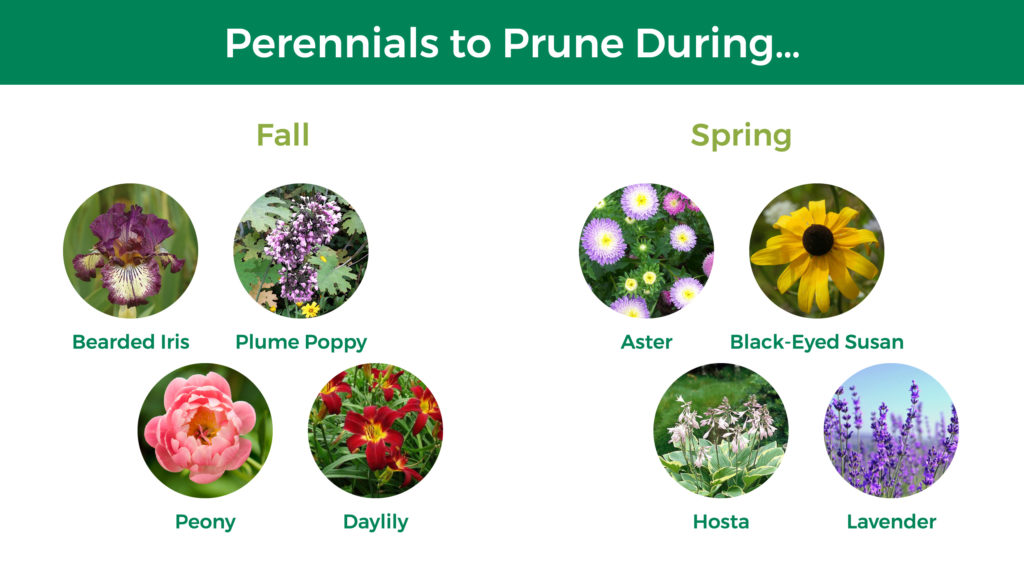
Perennials that prune during fall: bearded iris, plume poppy, peony, and daylily. Perennials that prune during spring: aster, black-eyed Susan, hosta, lavender.
How to Make the Cut
Depending on plant type, size, and flowering capacity, methods for pruning and deadheading vary. In general, though, it’s best practice to make any pruning cuts at approximately a 45-degree angle, leaving a stub of the stem or branch. For vertical veggies like tomatoes and peppers, remove any suckers (between the main stem and leaves) and dying leaves at the bottom to promote the flow of air and water. As a simple gauge, you should be able to see a little light through vegetable plants at all times. For vining veggies and fruits like squash and cucumbers, cut off growth points that will not bear any crop. Pinching off flowers from veggies and herbs will concentrate energy on existing fruits.
With flowers, sever the stem below the spent flower but just above the first set of healthy leaves. For stalks that are thin and soft enough, like those of many perennials, you may simply use your fingers to pinch off the old blooms. Scissors are best for trimming delicate, small-flowered plants, while hand pruners are best for plants with large flowers such as coneflowers, daylilies, or repeat-flowering roses. Be sure you don’t cut below any unopened buds, but if the entire stalk length has bloomed, simply remove the stalk from the base. Sometimes, shearing the entire plant can be most efficient if there are many flowers past their prime in a concentrated area. Cut back the top few inches, or about one-third of the plant. It will recover quickly and look fuller as a result.
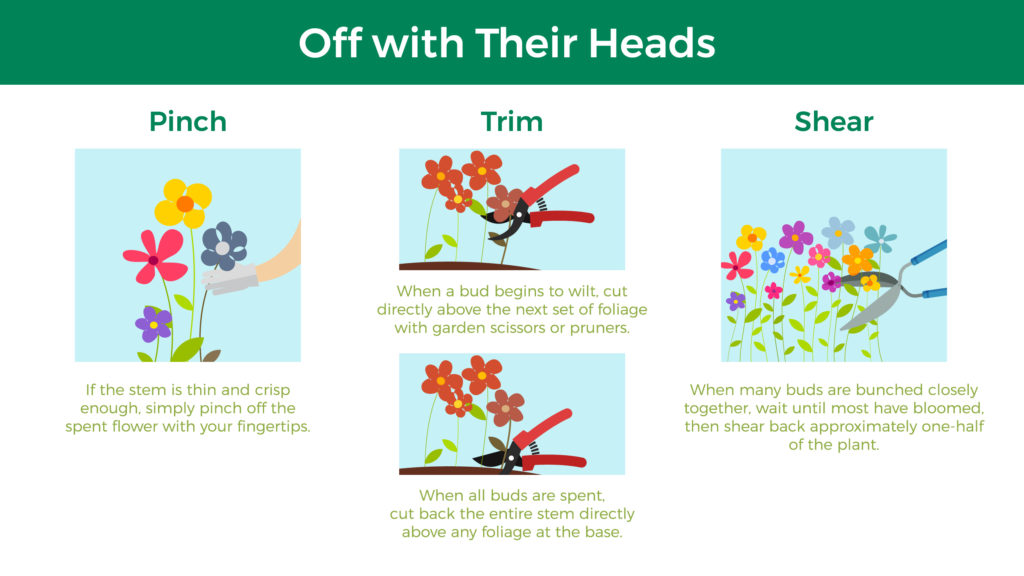
Off with Their Heads: 1) Pinch: If the stem is thin and crisp enough, simply pinch off the spent flower with your fingertips 2) Trim: When a bud begins to wilt, cut directly above the next set of foliage with garden scissors or pruners. When all buds are spent, cut back the entire stem directly above any foliage at the base. 3) Shear: When many buds are bunched closely together, wait until most have bloomed, then shear back approximately one-half of the plant.
Keep Your Garden Growing Strong
Pruning and deadheading tactics can be hugely beneficial to the appearance and wellbeing of your flowering plants. At Jobe’s, we know you can’t raise a healthy garden without the essentials like proper soil, eco-friendly fertilizers, and protective accessories. Our environmentally-friendly range of products has something to fulfill all your gardening needs.
